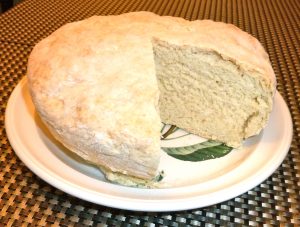The history of food in BC gives a new meaning to “food on the go”. Ship passenger lists published in the British Daily Colonist from 1858 into the 1860s frequently list miners and sappers as occupations. Sappers were “ready to do anything or go anywhere” according to Beth Hill (1987, p. ix) who described sappers as, “ a man of all work of the Army and the public – astronomer, geologist, surveyor, draftsman, artist, architect, traveller, explorer, antiquary, mechanic, diver, soldier and sailor”. The sappers were members of the Royal Engineers who first came to British Columbia in 1858. They helped layout and build roads and townsites, map the terrain, and keep the peace when needed. But, what did they eat?
One sapper described a meal eaten in a tent labeled “American Restaurant” in Fort Yale in 1858, then a tent city. There was one large table that everyone shared and the meal consisted of old fish, dried salmon, and undrinkable coffee.
In 1859, Lieutenant Mayne tasked with surveying roads in the Fraser River area described the food stocks he carried. “Our fare…consisted almost exclusively of bacon and dampers, with tea and coffee. Now and then we might be lucky enough to shoot a grouse.” Dampers were “cakes of dough rolled out to the size of a plate, and one or two inches thick. They are cooked either by being baked in the wood ashes of the fire or fried in the pan with bacon fat” (Hill, 1987, p. 55).
In 1862, Sergeant-Major John McMurphy worked on wagon road construction south of Quesnel. He kept a journal and commented on the food. “A case of Brandy and a box of preserves for our gruel arrived as we complained of having nothing to eat but beans and bacon three times a day which is a very good thing now and then, but 21 times a week is too often” (Hill, 1987, p. 103). McMurphy did note in his journal later in the year that settlers along the road had already planted gardens and had vegetables to sell to the miners.
Lt. Mayne’s mention of dampers led me to look further into what exactly they were. We can thank Australia for dampers, considered one of Australia’s “most iconic symbols of bush life,” a mixture of flour, salt, and water, made famous by drovers who baked the bush bread in the coals of their camp fire (Little Aussie Travellers.com). Food History Timeline, a source from Australia claims that dampers were first mentioned in 1825 and the word derived from “dampening the appetite” or damping the fire, a procedure of covering the red coals with ashes and thus preserving them in order to re-kindle the fire the following morning.
There is great similarity between dampers and bannock that was commonly prepared on the Canadian prairies. Both retain their relevance today for campfire cooking. The dough is baked in a pan over a fire or rolled around a stick and held over the fire to bake. Dampers though were also baked in the ashes – simply buried and then when baked the outer ashy crust was removed and the bread enjoyed. Dampers like biscuits or bannock today are updated through the addition of fruit, nuts or savoury ingredients to make a delicious quick bread. I tried the following recipe and was surprised how delicious it was fresh from the oven!
Dampers (source: http://www.food.com/recipe/australian-damper-22353)
2 ½ cups of flour
5 teaspoons of baking powder
1 teaspoon salt
1 teaspoon butter
1 teaspoon sugar
1 cup milk, fresh, powdered (or use water)
Mix together the dry ingredients, then add liquid and butter and mix well.
Knead until it holds together and is still slightly lumpy.
Wrap it in a double layer of greased foil and place it in the coals of a campfire or
bake in the oven, preheated to 350 degrees.
Shape the dough into a flattened ball and place on a greased baking sheet.
References:
Hill, B. (1987). Sappers, The royal engineers in British Columbia. Ganges, BC: Horsdal & Schubart

